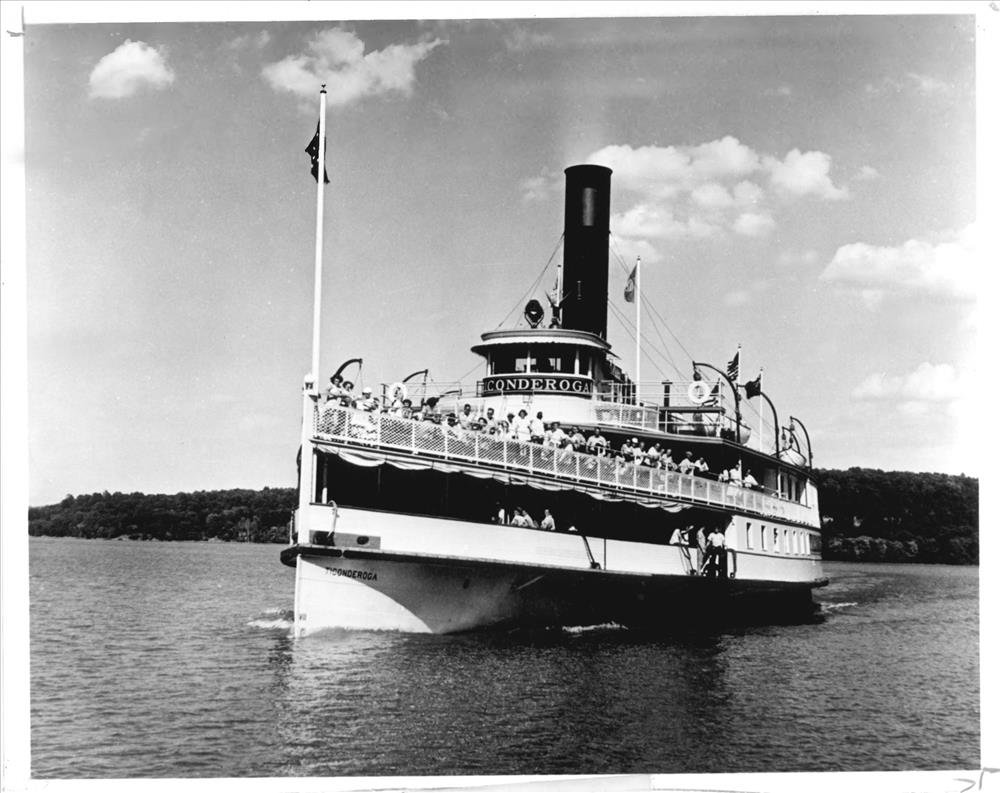Did You Know? - Ticonderoga Steamship Part 1: Teenage Deckhands
The Steamboat Ticonderoga on Lake Champlain. Image courtesy of the National Register of Historic Places.
The VT Folklife Archive is full of amazing first-person accounts of everyday life in Vermont and New England–past and present. In this feature, we share these stories with you.
The steamboat Ticonderoga is a National Historic Landmark that lives on the grounds of the Shelburne Museum in Shelburne, VT, where it portrays life onboard in 1923. This year, then, a trip aboard the “Ti” is a trip 100 years back in time.
Before its arrival at the museum, the Ticonderoga had a thriving life on Lake Champlain from 1906, when it was built, until 1953, when it was the final remaining paddlewheeler on the lake.
Vermont Folklife is proud to have a collection of interviews of many of the people who lived and worked on the Ticonderoga during that time. We're in the season of summer jobs, so in this month’s “Did You Know?”, we’ll look back 70–80 years ago and focus on the stories of teenage deckhands who worked on the “Ti”. In particular, we feature the voices of Jerry Aske, Bill Adams, and Dick Adams, recorded in interviews with VT Folklife founder Jane Beck in the late 1990’s.
Jerry talks first with Jane about the basic deckhand responsibilities, referring affectionately to Captain Alanson Fisher (“Cap”) and his son and the pilot of the Ti, Martin (“Marty”) Fisher:
Jerry Aske: Well, we had to be on deck for docking, leaving port, returning to port. Handling the lines was pretty important to the captain because, as I mentioned, you can’t steer this boat with its engines. So the spring lines is what he would, he would work against the spring lines to get the bow away from the dock, get the stern away from the dock, or conversely to swing the stern in or swing the bow in, so you had to have those lines on shore as quickly as possible and then play with them on the cleat, as he slacked or tightened. That was probably the most important thing, but then all the rest of the time was either patrolling the decks during the cruise, make sure that nobody is drunk falling overboard, or anything like that. [Chuckles] And then after cruises, between cruises, was clean–scrub and hose and polish. That's how I became first mate. Which, first mate in name only; it meant that I could tell the other guys what to do but Cap caught me polishing door knobs one day when everybody else was ashore and I hadn't been told to do that. And, I don’t know, I just thought they'd look better if they were polished, these brass doorknobs. So he, I think he was as surprised as anybody, because he knew me as a kid, and he knew I was lazy and spoiled. So, I think I surprised him and so he, I guess he must have talked to Ralph Hill and Marty and a little while later they approached me and said, "Would you like to be first mate?" "And what does that entail?" "Well, you're the boss now of the deckhands." I said, "Okay, fine. How much more do I get?" "Well, you don't get any more money, but." Ha! Ha! So that's what happened.
Bill talks with Jane about the standard that Captain Fisher set for the ship, and what the boys had to do to maintain it:
Bill Adams: Wednesdays was brass day. And you'd get a little pint can of brass polish, a couple of rags, and then you'd get assigned different places and boy, everybody didn't want the, they didn't want the pilot house. First of all, that's where the Fishers were all the time so they could tell if you did a good job. And second of all, there was a lot of brass up there, you take the compasses and the clocks and the, oh where they spoke to the, the thing was brass at the end, you know. But I mean, every week, every bit of brass on that ship was polished and you go in there and I don't know if you looked, but the doorknobs going down to the staterooms. And, you know in the, everything, down in, even down where Dick shoveled coal, we were down there with the meters, and we had to do the brass around the old brass meters. That was Wednesday. I always remembered that brass day.
As a steamboat, the Ti had fires that needed to be constantly fed with coal. Dick Adams worked on the Ti in its later years, when it was serving as a cruise boat on the lake. His work involved spending part of the time in the boiler room, shoveling coal for the fires. Here, he shares with Jane what that was like:
The boiler room on the Ticonderoga.
Dick Adams: And we had all kinds of experiences like that, learning all about the boat and at that time, I think I was sixteen years old. We shoveled—on an average run we'd shovel anywhere from a ton to a ton and a half of coal an hour. Usually it took several ton of coal just to get the, to get the fires going, to get the steam up. And then again, while we were in motion it depended on the weather, whether the wind was blowing, if the draft was just right or not, as to how much coal we did burn and what speed we were going. Normally we'd have an excursion out of Burlington once or twice a week. Most every night, we'd go to Plattsburgh for an excursion. Every Wednesday evening we'd have an excursion out of Basin Harbor, The Basin Harbor Club, which all us deckhands and the young guys working on the boat enjoyed that the most because it had a buffet style supper they'd have. And they always had nice looking girls working at the buffet. So, we thought that was a pretty good trip.
Many of the boys would return to the ship for a subsequent summer. As Dick Adams learned how things worked, he got some ideas about improving his experience. Here, he tells—with a twinkle in his eye—about trying to finagle some extra benefits from Marty:
Dick Adams: The second year I was on the boat, of course us young guys got along fine, we never had any trouble amongst ourselves, which is good. But I was always after a little more, you know, and I told Marty one day, I said, "You know, I can't sleep very good at night, I got to get up earlier than the rest of them to get the fires going and I don't get the rest I should." I said, "I notice there's some little, little cabins behind the pilot house. And one of them is empty, there's nothing in it." I said, "Do you suppose I could have that?" Ha! Ha! So, he looked at me, I know he knew I was just trying to get something nobody else had. And he said, "Okay. You can have the pilot, the cabin." So I had all my stuff up there, I had my own little cabin with a bunk and a place to store my clothes, and but right after I moved up there, all the deckhands would come up at night with their mattresses and [laughs] would sleep out on the deck anyway so, we were still all together. We used to do that a lot. If it wasn't going to rain, we'd pull our mattresses up there on the deck and just lay there looking at the stars and visiting and we'd fall asleep. You know that way. And a, a nice cool breeze. It was, it was nice.
Dick's ongoing work on the Ti as a teenager provided him with delightful memories of his friends and co-workers. However, it also gave him an opportunity to gain extra responsibilities, as well as gain confidence in his growing abilities:
Dick Adams: I started out that year as a deckhand. I might have worked three weeks as a deckhand and then Marty Fisher came to me one day and asked me if I'd be interested in firing the boilers or learning how. And of course, because my dad had done it, I decided that would be a great thing to try. And I worked with Bill Wright for a while. We mentioned him before. I worked with Bill and once I learned the tricks of the trade, you might say, I started firing the boilers regular.
Jane Beck: Tell me a little bit about how Bill Wright taught you.
Dick Adams: Well basically he taught me what he had been taught from older men, some of the engineers. At that time, it was Chief Bigelow from New York State. He was, I think he was in his 80s at the time, and he was a nice old gentleman, real pleasant to work for and anxious to teach you all he knew. And that's how Bill learned I think from Chief Bigelow. And, well we went on that summer, I learned a lot about the boilers and the equipment on the boat. The chief taught me about the different pumps and how to maintain them and what to do. And he took a liking to me apparently because he taught me how to run the engine. And at times he'd let me take the boat out from the dock. And I really enjoyed that. We were leaving one day and normally it was just a routine thing, you back up on the stern line which would pull the boat away from the dock. And then, Marty would ring for half speed ahead, and you'd start your engines going all by hand, opening and closing the valves by hand and it was a routine thing. You'd back out then you'd go ahead. But this particular day, I backed out and we started to go ahead, and the bell rang for stop, and back up again and stop. And back and forth. And of course I didn't know what was going on, I couldn't, you can't see, when you're in the engine room you can't see anything only the engine. And paying attention to the indicator on the wall so I wouldn't make any mistakes. And finally, we got in motion and going ahead, and I got the boat in automatic you might say. And Marty showed up at the engine room door. He said, "Did you do that?" And I said, "Yes." He said, "I thought it was Chief Bigelow in here." I said, "No, it was me." Ha! Ha! So, it made me feel pretty good to know that he thought it was the chief in there instead of myself.
The experiences of the deckhands provide one picture of life on the Ti. We'll continue next month with a "Did You Know?" about how the ship worked, with descriptions from various folks about the incredible collaboration that had to happen onboard to keep her running smoothly. We’ll learn what it means to "pull the fires"—a show not to be missed by those on shore.


